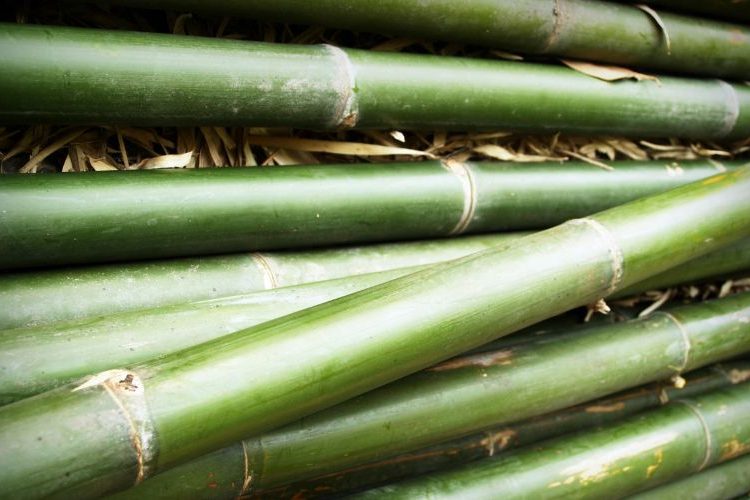These days, it’s easy to spot bamboo products from Vietnam in U.S. retail stores and online shops on Etsy or Amazon. From kitchenware to home décor, they’re becoming more and more common. This shows that Vietnamese bamboo has what U.S. buyers value most: it’s durable, safe for everyday use, and has a natural look that fits today’s lifestyles.
If you’ve been wondering how to import bamboo from Vietnam without unnecessary hassle, this guide is here to help. We’ll walk through which products are easy to sell, how to find trustworthy suppliers, and what customs procedures you need to know. You’ll come away with a clear idea of how to handle your first import with confidence.
Facts About Vietnam’s Bamboo Industry
Over the first five months of 2025, Vietnam’s bamboo and rattan exports have been growing steadily, reaching close to 370 million USD. What’s interesting is that the U.S. now takes the lead, making up nearly half of that number with imports worth about 171 million USD. That’s a solid 25 percent increase from last year.
For U.S. buyers, the bestsellers from Vietnam are easy to spot: bamboo furniture like chairs and storage pieces, simple yet stylish home décor, handy kitchen items such as cutting boards and trays, and plenty of other eco-friendly crafts that match the shift toward sustainable living.
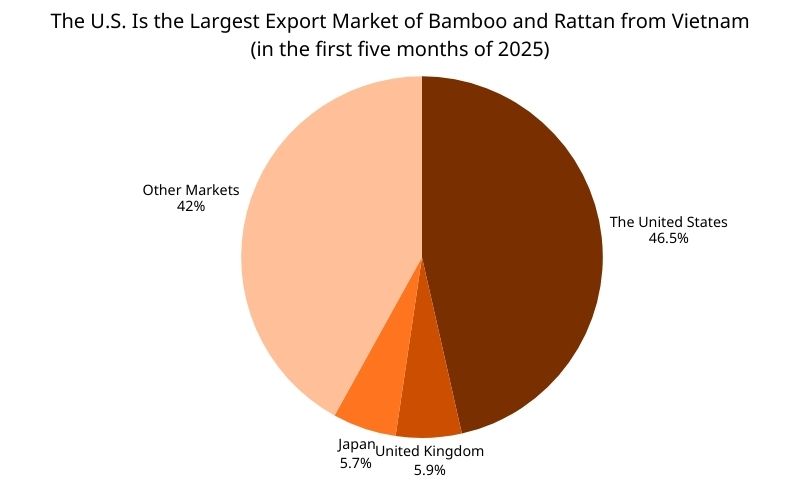
Benefits of Importing Bamboo Products from Vietnam
If you’re still unsure about the business potential of Vietnamese bamboo, the points below might give you the encouragement you need.
- Vietnam has a long tradition of bamboo craftsmanship. Artisans in traditional villages have been making bamboo goods for generations and have abundant bamboo resources.
- The country also has one of the largest bamboo-growing areas in the world, with over 200 native varieties. Among them are strong and dense species like luồng, lùng, and trúc sào. These species offer thicker culms and greater structural strength, which is perfect for furniture, flooring, and other heavy‑duty uses.
- Import duties on Vietnamese bamboo goods to the U.S are lower than those from China, a longtime leader in this category. Duties can be as low as 3 to 8 percent. This can help U.S. businesses boost margins without compromising quality.
- Sustainability is part of the story. Many producers use eco-friendly farming guided by the Vietnam Bamboo Organization. With FSC and VFCS/PEFC certifications, you can offer products that meet growing demand for sustainable and ethically made goods.
- Vietnam enjoys Most Favored Nation status with the U.S., which helps keep tariffs more favorable and the supply chain more stable. Tariffs on bamboo furniture, for instance, start from as low as 3.2% for long-term import.
Popular Types of Vietnamese Bamboo Products For Importing
Here are a couple of common categories you might want to explore for your own sourcing.
1. Bamboo Furniture
Furniture is by far the biggest bamboo category that Vietnam ships to the U.S. In 2023, the country sent about 30.9 million USD worth of bamboo furniture to the world, and nearly 70% of this was directly exported to buyers in the U.S.
Popular pieces include lounge chairs, dining chairs, writing desk, and small side tables.
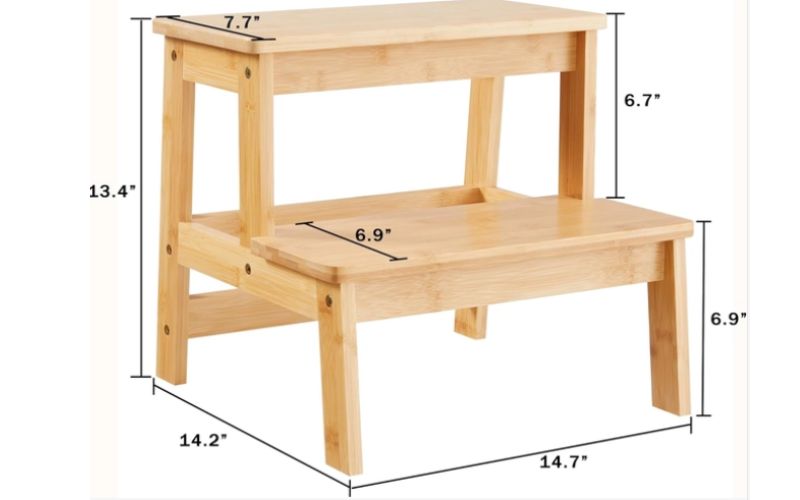
2. Bamboo Handicrafts
In 2024, Vietnam’s total export value for handicrafts (including bamboo) reached approximately 804 million USD. Within this group, bamboo handicrafts often refer to handmade decorative products such as bamboo figurines, foldable fans, gift boxes, and ornamental craft pieces used for gifting, souvenirs, and cultural displays.
3. Woven Bamboo/Rattan Household Items
Demand for woven bamboo and rattan household items is also strong. In April 2025 alone, Vietnam exported 79.05 million USD worth of bamboo/rattan goods. Key products in this category include woven laundry hampers, rattan trays, storage cubes, and tissue boxes.
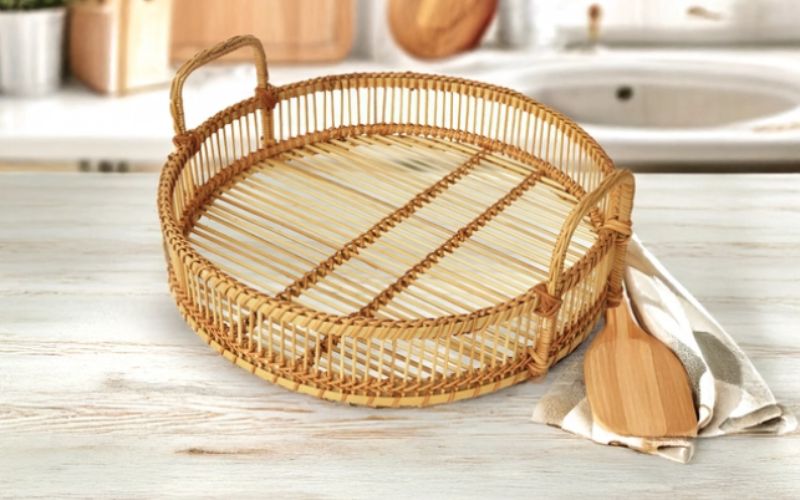
4. Bamboo Mats & Carpets
The most popular product in this category is the traditional bamboo sleeping mat. In 2023, the global export value for carpets and textile floor coverings was around 340 million USD. The sub-category of bamboo mats includes bamboo sleeping mats, foldable floor mats, and natural bamboo blinds used as floor cover.
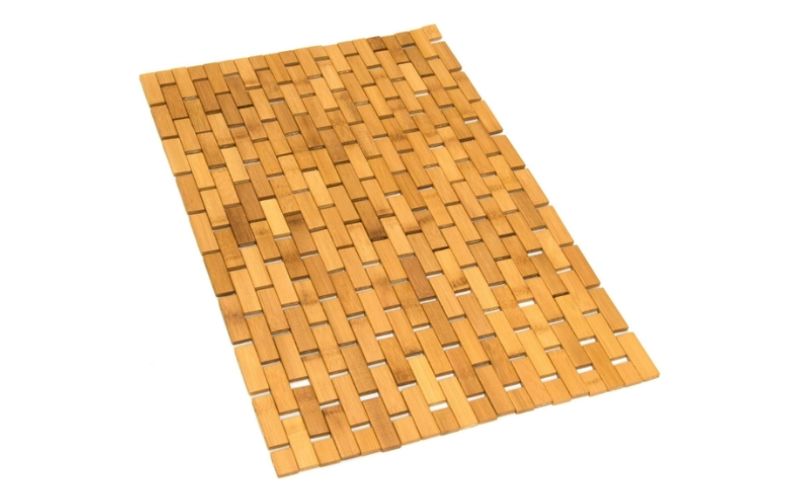
Where Can You Find Bamboo Suppliers in Vietnam?
When you’re just starting to figure out how to import bamboo from Vietnam, it’s easy to feel unsure about where to find the right suppliers. Here are a few simple ways:
1. Traditional Bamboo Craft Villages
Places like Xuan Lai in Bac Ninh and Phu Vinh in Hanoi are well-known for bamboo. A trip there lets you see the products with your own eyes and watch how artisans make them by hand. The only catch is the time commitment; you’d likely need a couple of weeks away from your business in the U.S. to travel and explore.
| # | Place | Famous for |
| 1 | Xuan Lai (Bac Ninh) | Black-lacquered bamboo vases, trays, home decor |
| 2 | Phu Vinh (Hanoi) | Traditional hand-woven rattan baskets and panels |
| 3 | Chuong My (Hanoi) | Decorative bamboo screens, partitions, wall art |
| 4 | Kim Son (Ninh Binh) | Seagrass and bamboo carpets, mats, multi-materials |
2. Bamboo Trade Fairs in Vietnam
There’s currently no dedicated national expo only for bamboo items, but bamboo is regularly featured in several major trade fairs. These include VIFA Expo (Vietnam International Furniture & Home Accessories Fair), HAWAExpo, and Lifestyle Vietnam, all of which showcase bamboo furniture, homeware, and handicrafts as official product categories.
Just keep in mind these fairs usually happen once a year, and the dates can shift, so it’s worth following the organizers closely.
3. Online Sourcing Platforms
If you want a quick overview, online platforms are the most convenient option. They allow you to filter by product type, supplier location, or certifications to find verified bamboo manufacturers.
Top platforms for sourcing bamboo items:
- Alibaba: global B2B sourcing with thousands of Vietnamese bamboo listings
- Global Sources: international directory for verified factories
- Made-in-China: includes Vietnam-based bamboo exporters
- VinaSources: sourcing site focused on Vietnamese manufacturers
- Vietnam B2B Marketplace (vietaz.com): local supplier discovery tool
Notable bamboo-focused suppliers from Vietnam:
- Dantra: specializes in premium rattan/bamboo furniture and home decor
- Oceans Republic: focuses on eco-friendly bamboo utensils and kitchenware
- BambuBuild: supplies bamboo construction materials and prefab buildings
- Viettime Craft: exports woven baskets, vases, seagrass and bamboo decor
- LaviCrafts: custom handmade bamboo & rattan gifts for international markets
How to Import Bamboo from Vietnam: Working with Vietnamese Bamboo Suppliers
Once you’ve picked a supplier that looks like a good fit, the next step is to make sure you really understand how they work and what you can expect.
1. Request Product Samples and Inspect Quality
Before placing a big order, always start small with samples. Share a simple product brief with your supplier that includes photos, dimensions, any extra materials, and, if it’s for your own brand, details like packaging design or logo placement. Also, be clear about how many samples you want, so you have a backup in case one gets damaged during shipping.
When the samples arrive, take a close look. Items made from good bamboo should:
- Feel smooth
- Have an even color
- Be free from black spots or leftover moisture
If it’s something functional, like a folding chair, test it out: does it feel sturdy? Does it open and close easily? A hands-on check like this will give you confidence before moving forward with a larger order.
2. Confirm MOQ, Production Time, and Payment Terms
Most bamboo suppliers in Vietnam already set a minimum order quantity for each product. For your first order, it’s always worth asking if they can be flexible.
Production time usually starts at around 20 days, but it can vary a lot depending on the design and the season. During peak times like the New Year and Lunar New Year, production can slow down, so it’s smart to add some buffer time or avoid placing big custom orders right before the holidays. Here’s a quick idea of what to expect:
| # | Main Category | Common MOQ | Typical Lead Time |
| 1 | Furniture (chairs, tables, shelves) | About 100 to 500 pcs | 20 to 40 days |
| 2 | Handicrafts (wall panels, wind chimes, lampshades) | 50 to 100 pcs | 20 days or more |
| 3 | Woven household items (baskets, trays, holders) | Normally 100 pcs | 15 to 20 days |
| 4 | Plain mats and carpets | 200 to 1000 sheets | Around 30 days |
As far as payment is concerned, most suppliers are very reasonable. The usual practice is to pay about thirty percent upfront by bank transfer, with the balance due before shipping.
3. Agree on Customizations and Packaging Requirements
If you’re planning to sell under your own brand, this part really matters. You can start by:
- Listing the key measurements you need and mentioning the tolerance range you’re comfortable with.
- Describing the finish you’d like, whether that’s smooth sanding, a polished surface, or an oil coat.
- Specifying the type of bamboo to use and whether it should go through any pre-treatment, such as mold or insect protection.
- Sharing your branding requests, like logos, laser engraving, or other design details, along with clear notes on placement and size.
4. Collect All Required Export Documents from Supplier
Good products are important, but without the right paperwork, they won’t make it past customs. That’s why it helps to double-check with your supplier that everything is in place before shipping. The basics usually include:
- Commercial Invoice
- Packing List
- Bill of Lading or Airway Bill
- Certificate of Origin
- Phytosanitary Certificate
- Fumigation Certificate
How to Import Bamboo from Vietnam to the USA
Finding a good supplier in Vietnam is just half the journey. The other half is getting your products through U.S. Customs and Border Protection (CBP) so they can actually reach your customers.
1. Classify Your Bamboo Product into the Right HS Code
Making sure that your bamboo products are classified under the right Harmonized Tariff Schedule code not only tells you what duties to expect but also helps you identify which U.S. agencies might need to review your shipment before clearing customs. Since bamboo can be used in so many ways, there are dozens of possible codes.
Here are some common ones for Vietnamese bamboo products in US and their normal duty rates:
| # | Product Type | HTSUS Code | General Duty Rate |
| 1 | Woven mats, panels, or folding screens (bamboo) | 4601.21.40.00 | Free |
| 2 | Bamboo baskets, handwoven trays, containers | 4602.11.09.00 | 10% |
| 3 | Laminated bamboo trays, boxes, holders, bins | 4420.90.8000 / 4500 | 3.2% – 4.3% |
| 4 | Flat bamboo panels, laminated boards | 4412.10.9000 | Free |
| 5 | Kitchenware & tableware (e.g. plates, cutting boards) | 4419.11.90.00 | ~3.2% |
| 6 | Bamboo plaits and strips (crafts, weaving materials) | 4602.11.07.00 | Varies, up to 8–10% |
2. Check If Your Product Requires FDA, USDA, or CPSC Approval
Bamboo can be turned into thousands of different products, and depending on the final use, different U.S. agencies may want to review them. FDA, USDA, and CPSC are the main regulatory bodies overseeing product safety, plant health, and food contact materials.
Most finished bamboo products, like furniture or decorative items, do not require a USDA import permit. But some other bamboo products exported to the U.S. definitely require approval.
- CPSC (Consumer Product Safety Commission): Oversees bamboo goods intended for children, such as toys, baby furniture, or learning tools. These products must meet U.S. child safety standards.
- FDA (Food and Drug Administration): Oversees bamboo products that come into contact with food, like bowls, plates, cutting boards, or chopsticks.
- USDA (U.S. Department of Agriculture): Oversees raw or semi-processed bamboo materials that may pose agricultural risks, such as untreated poles or plant-based crafts.
3. Prepare and File the Correct Import Documentation
Most bamboo products coming into the U.S. need a Lacey Act Declaration, and that applies to shipments from Vietnam as well. The declaration usually asks for:
- The scientific name of the bamboo (genus and species)
- The quantity and value of your shipment
- The country where the bamboo was grown (Vietnam, in this case)
- The type of bamboo used
- The percentage of recycled content, if any
Certain supporting documents may be required depending on the type of bamboo product being imported:
- For bamboo panels, flooring, or wall fixtures used in commercial or public spaces (e.g. retail stores, restaurants, hotels): Certificate of compliance with flame spread standards (e.g. NFPA 255 or ASTM E84) for building materials.
- Bamboo goods with adhesives, resins, or surface coatings (e.g. laminated boards, treated furniture): Formaldehyde emission test report or third-party certification showing compliance with EPA TSCA Title VI standards.
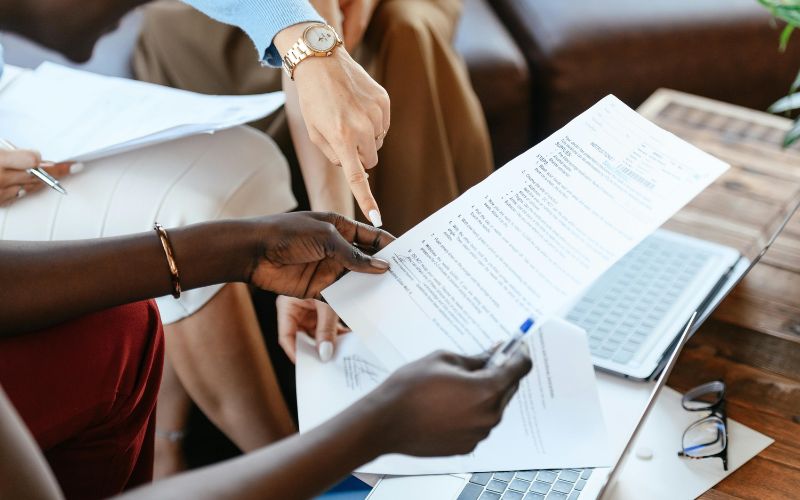
4. Ensure Your Product Labeling Meets US Requirements
Product labels need to be in place before your goods leave Vietnam and must stay on the packaging until they reach the point of sale in the U.S. For packaging made from wood, it’s important to include the mark approved by the International Plant Protection Convention.
There are also a few details that must appear on the label and packaging, such as:
- The country of origin, clearly marked as MADE IN VIETNAM
- The exact product name
- An identification number that matches what’s listed on the commercial invoice
There are also category-specific rules. Below are some labeling requirements for certain bamboo product types:
| # | Product Type | Labeling Requirement |
| 1 | Bamboo textiles (T-shirts, socks, towels, etc.) | If made from regenerated cellulose (e.g. rayon/viscose), the label must state “rayon made from bamboo”, not just “bamboo.” Unproven eco-claims like “naturally antibacterial” are prohibited. |
| 2 | Bamboo kitchenware / tableware (plates, chopsticks, etc.) | If made from bamboo powder + melamine, must not be labeled “100% bamboo.” Required to state “bamboo and melamine blend” or equivalent. |
| 3 | Disposable bamboo tableware (spoons, cups, straws, etc.) | If in contact with food, labeling must include usage purpose (e.g. “safe for food use”). Product must comply with FDA food-contact rules. |
| 4 | Bamboo cutting boards / kitchen utensils | Must reflect actual construction: e.g. bamboo veneer ≠ “solid bamboo.” Avoid misleading material claims. |
| 5 | Bamboo furniture / home décor | Must include country of origin and correct material description. If surface-treated or chemically coated, labeling must reflect any relevant consumer impact. |
5. Book Shipment and Choose the Right Incoterm
Once you’ve chosen a freight forwarder and decided whether to ship by sea or air, it’s time to lock in your order. Double-check the details with your forwarder about things like delivery dates, costs, and who’s responsible for what. After that, they’ll arrange pickup from your supplier in Vietnam and take care of moving the goods to the port or airport.
Incoterms are simply the rules that spell out who handles which part of the shipping:
- If you’ve shipped by sea before, FOB is often a good fit. Your supplier will handle everything until the goods are loaded on the vessel in Vietnam, and then the responsibility shifts to you.
- If you’d prefer less hassle, DDP is the simplest. The supplier takes care of almost everything, including insurance, until the shipment shows up at your warehouse.
6. Calculate Import Duties and Handle Customs Clearance
It’s worth noting that duties are not the final total costs. There are also insurance, freight, and customs fees, which reduce your profit if not calculated right. For bamboo or other products imported to the USA, here is how duties are calculated:
Import Duty = CIF value × Duty Rate + Additional Tariffs
In which:
- CIF value: Cost of goods + Insurance + Freight. This is the declared value of your shipment used by U.S. Customs to determine how much duty is owed.
- Duty Rate: The rate based on the product’s HTSUS code, origin country, and any special tariffs applying.
- Additional Tariffs: Any extra duties imposed. Currently, the U.S. applies a 20% reciprocal tariff on many goods imported from Vietnam, including bamboo products.
Say you’re importing bamboo baskets with a CIF value of 20,000 dollars. The HTSUS code for bamboo basketwork is 4602.11, and the general duty is about 5 percent. With the extra 20 percent tariff, the calculation would look like this:
- General duty: 20,000 x 5% = 1,000 dollars
- Extra tariff: 20,000 x 20% = 4,000 dollars
- Total duties: 5,000 dollars
Since this can feel like a lot to manage, many importers work with a licensed customs broker to ensure everything is filed correctly. Keep in mind that CBP and the USDA often inspect shipments upon arrival in the U.S., so having a quality control team in Vietnam check your goods before shipping can help avoid delays or unexpected fines.
Other Things to Consider When Importing Bamboo from Vietnam
These extra points might seem small, but they can make your import process much smoother. First of all, be aware of extra costs. Import duties, customs fees, and storage charges can add up. Knowing these ahead of time helps prevent surprises.
Also, use the right communication channels. Most suppliers confirm contracts and important information by email, but day-to-day chats often happen on Zalo, which is like WhatsApp. Having an account makes keeping in touch easier.
VinaSources is a top B2B platform for finding bamboo suppliers in Vietnam. We help you connect directly with trusted suppliers and stay by your side through every step, from sourcing and quality checks to shipping and compliance. Whether you’re after raw bamboo or finished products like furniture or kitchenware, there’s a good chance our bamboo catalogue already has suppliers that fit your needs.
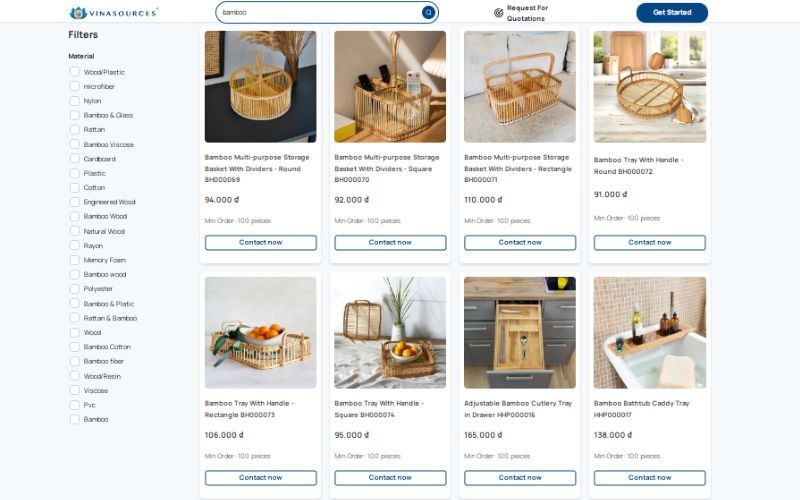
Send your Request for Quote (RFQ) today and get verified quotes from multiple suppliers quickly!
